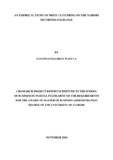| dc.description.abstract | Price clustering is a phenomenon where some prices are observed more frequently than
others. Several hypotheses have been put forth to explain this phenomenon. This study
therefore set to empirically investigate price clustering phenomenon on the Nairobi Securities
Exchange for the period 2009 to 2013. The study used secondary sources of data obtained
from the Nairobi Securities Exchange and revealed that there is a preference by investors for
stock whose prices end with the digit 5 which accounted for 67.88 percent of all the stocks
examined. This was followed by stocks whose prices ended with the digit 0 which accounted
for 4.55 percent. In order to establish the determinants of this observed behaviour, a
multivariate regression model was adopted where price clustering was regressed against stock
volatility, number of trades, market capitalization, and own stock price. The regression results
indicated that the number of trades and market capitalization were positive and significantly
related to price clustering. Stock price was found to be negative and significantly related to
price clustering. On the other hand, stock volatility was established to be an insignificant
predictor of price clustering. The multivariate regression model was found to be significant in
explaining the observed relationship and that 15.4 percent of the variance in price clustering
was explained by the number of trades, stock volatility, own stock price and the market
capitalization | en_US |

